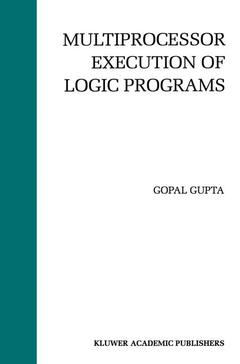Description
Multiprocessor Execution of Logic Programs, Softcover reprint of the original 1st ed. 1994
Author: Gupta Gopal
Language: English
Subject for Multiprocessor Execution of Logic Programs:
Keywords
Prolog; logic programming; processor; programming; programming language
Approximative price 158.24 €
In Print (Delivery period: 15 days).
Add to cart
Publication date: 10-2012
243 p. · 15.5x23.5 cm · Paperback
243 p. · 15.5x23.5 cm · Paperback
Description
/li>Contents
/li>Comment
/li>
Multiprocessor Execution of Logic Programs addresses the problem of efficient implementation of logic programming languages, specifically Prolog, on multiprocessor architectures. The approaches and implementations developed attempt to take full advantage of sequential implementation technology developed for Prolog (such as the WAM) while exploiting all forms of control parallelism present in logic programs, namely, or-parallelism, independentand-parallelism and dependent and-parallelism. Coverage includes athorough survey of parallel implementation techniques and parallelsystems developed for Prolog.
Multiprocessor Execution of Logic Programs is recommended for people implementing parallel logic programming systems, parallel symbolic systems, parallel AI systems, and parallel theorem proving systems. It will also be useful to people who wish to learn about the implementation of parallel logic programming systems.
Multiprocessor Execution of Logic Programs is recommended for people implementing parallel logic programming systems, parallel symbolic systems, parallel AI systems, and parallel theorem proving systems. It will also be useful to people who wish to learn about the implementation of parallel logic programming systems.
1. Introduction. Part I: Survey and Analysis of Parallel Execution Models. 2. Parallel Execution Models for Logic Programs. 3. Analysis of Or-parallel Models for Logic Programs. Part II: Combining Independent And- and Or-parallelism. 4. Environment Representation. 5. Distributed Stack Implementation and an Abstract Machine for And-Or Parallel Execution. 6. Optimizing And-Or Parallel Models. Part III: Extensions and Variations of the And-Or Model. 7. Integrating Dependent and-, Independent and-, and Or-parallelism. 8. And-Or Parallel Implementation of Prolog. 9. Conclusions. Bibliography. Index.
This book addresses the problem of efficient implementation of logic programming languages, specifically Prolog, on multiprocessor architectures. The approaches and implementations developed attempt to take full advantage of sequential implementation technology developed for Prolog (such as the WAM) while exploiting all forms of control parallelism present in logic programs, namely, or-parallelism, independent and-parallelism and dependent and-parallelism. Coverage includes a thorough survey of parallel implementation techniques and parallel systems developed for Prolog.
© 2024 LAVOISIER S.A.S.




